Designing a Photovoltaic–Wind Energy Mix with Energy Storage for Low-Emission Hydrogen Production
Abstract
1. Introduction
- Energy storage. Energy storage systems, such as lithium-ion batteries, allow for the storage of surplus generated energy during periods of high production and its use during periods of energy shortage [10]. Energy storage technologies in the form of compressed air (CAES) or hydrogen (Power-to-Gas) are also being developed [11].
- Digital solutions and smart grids (Smart Grid). Advanced network management systems enable dynamic control of energy flows [14]. By using predictive algorithms, it is possible to optimize the operation of the network depending on the forecasts of the energy production from RES and the demand of the recipients [15,16].
- Infrastructure for the distribution of power from renewable energy sources located in the region to future locations for the production of green hydrogen [26].
- Creation of infrastructure for the production of green hydrogen on an industrial and municipal scale, importantly located near future hydrogen recipients [27].
2. Materials and Methods
3. Component Characteristics
3.1. Power Generation by Photovoltaic Systems
- They maximize the total amount of energy reaching the panels during the day.
- Production peaks at noon, when the sun is at the highest point in the sky and the angle of incidence of sunlight is most optimal.
- The typical annual production for a well-optimized system in Poland is around 1000–1200 kWh per kWp.
- East: energy production is maximum in the morning and decreases in the afternoon.
- West: production increases in the afternoon and decreases in the morning.
- These systems spread production better throughout the day but do not achieve as high total production as south-facing systems.
- For south-facing PV panels: they generate peak power at noon, which often coincides with periods of high energy demand, but production before noon and in the afternoon is much lower.
- For east- and west-facing PV panels: production is more evenly distributed throughout the day, which can better match consumer demand in the morning (east) and afternoon (west).
- Optimal use of space: on flat roofs, east–west systems can accommodate more panels because there is no need to maintain large spacing between rows (less shading problems).
- Better match to demand: in some cases, the production spread better meets the needs of households and businesses.
3.2. Generating Power with Wind Turbines
- They are usually located far from the coast, where winds are stronger and more stable.
- Extreme environmental conditions, such as salt water, moisture, and strong waves, require additional protection against corrosion.
- The infrastructure must be resistant to the effects of sea currents, waves, and potential ice.
- They are located on hills, on open plains, or in mountainous regions where winds are sufficiently strong.
- Less extreme environmental conditions, which reduces construction and maintenance costs.
4. Results
5. Discussion
6. Conclusions
- The orientation of photovoltaic panels in the east–west direction significantly affects the amount of energy produced in individual hourly intervals compared to the orientation of the panels to the south. As a result of the orientation of the panels in the east–west direction, a significant increase in the share of energy from the photovoltaic system in the energy mix was observed in the hourly interval from 6:00 to 9:00 and a slight decrease in the remaining hours. However, it is worth noting that the hourly interval of the increase in production falls on the morning peak hours, when the cost of energy drawn from the power grid is very high.
- As a result of the orientation of the panels in the east–west direction, the power of the powered electrolyzers needed for perfect system balancing was reduced by less than 2.5%. This will reduce the production of green hydrogen by less than 1 kg per day. However, as a result of the orientation of the panels in the east–west direction, better energy balancing in the system was achieved, and the required energy storage system was reduced by over 27% from 7409 kWh to 5391 kWh. In this way, the thesis put forward at the beginning of this article that a structural influence on the construction and performance of photovoltaic systems is possible, having a very large impact on the power balancing of the entire system and contributing to the reduction in the capacity of the energy storage system, was positively verified. This means that it is possible to design the performance of the photovoltaic–wind mix for the production of low-emission hydrogen.
Author Contributions
Funding
Data Availability Statement
Conflicts of Interest
References
- Hoody, P.; Chiasson, A.; Brecha, R.J. The Transition to a Renewable Energy Electric Grid in the Caribbean Island Nation of Antigua and Barbuda. Energies 2023, 16, 6206. [Google Scholar] [CrossRef]
- Lian, J.; Fu, Q.; Cui, L.; Liu, R.; Guo, B. Offshore Renewable Energy. J. Mar. Sci. Eng. 2024, 12, 749. [Google Scholar] [CrossRef]
- Qiu, Z.; Tian, Y.; Luo, Y.; Gu, T.; Liu, H. Wind and Photovoltaic Power Generation Forecasting for Virtual Power Plants Based on the Fusion of Improved K-Means Cluster Analysis and Deep Learning. Sustainability 2024, 16, 10740. [Google Scholar] [CrossRef]
- Seward, W.; Chi, L.; Qadrdan, M.; Allahham, A.; Alawasa, K. Sizing, economic and reliability analysis of photovoltaics and energy storage for an off-grid power system in Jordan. IET Energy Syst. Integr. 2023, 5, 393–404. [Google Scholar] [CrossRef]
- Gryniewicz-Jaworska, M. Analysis of the Selection of Compensation Devices Determining the Reactive Power Balance of Wind Farms. Adv. Sci. Technol. Res. J. 2020, 14, 30–36. [Google Scholar] [CrossRef]
- Gryniewicz-Jaworska, M. Application of Heuristic Optimization for the Selection of Parameters of the Generation System and Reactive Power Consumption of Wind Farms. Adv. Sci. Technol. Res. J. 2020, 14, 9–14. [Google Scholar] [CrossRef]
- Dolge, K.; Blumberga, D. Transitioning to Clean Energy: A Comprehensive Analysis of Renewable Electricity Generation in the EU-27. Energies 2023, 16, 6415. [Google Scholar] [CrossRef]
- Małek, A.; Dudziak, A.; Caban, J.; Matijošius, J. Probabilistic Analysis of Low-Emission Hydro-gen Production from a Photovoltaic Carport. Appl. Sci. 2024, 14, 9531. [Google Scholar] [CrossRef]
- Małek, A.; Marciniak, A.; Bednarczyk, T. Probabilistic Analysis of Electricity Production from a Photovoltaic–Wind Energy Mix for Sustainable Transport Needs. Sustainability 2024, 16, 10164. [Google Scholar] [CrossRef]
- Li, N.; Lukszo, Z.; Schmitz, J. An approach for sizing a PV–battery–electrolyzer–fuel cell energy system: A case study at a field lab. Renew. Sustain. Energy Rev. 2023, 181, 113308. [Google Scholar] [CrossRef]
- Burian, O.; Dančová, P. Compressed Air Energy Storage (CAES) and Liquid Air Energy Storage (LAES) Technologies—A Comparison Review of Technology Possibilities. Processes 2023, 11, 3061. [Google Scholar] [CrossRef]
- Loza, B.; Minchala, L.I.; Ochoa-Correa, D.; Martinez, S. Grid-Friendly Integration of Wind Energy: A Review of Power Forecasting and Frequency Control Techniques. Sustainability 2024, 16, 9535. [Google Scholar] [CrossRef]
- Clifton, A.; Kilcher, L.; Lundquist, J.K.; Fleming, P. Using machine learning to predict wind tur-bine power output. Environ. Res. Lett. 2013, 8, 024009. [Google Scholar] [CrossRef]
- Güven, A.F.; Yücel, E. Sustainable energy integration and optimization in microgrids: Enhancing efficiency with electric vehicle charging solutions. Electr. Eng. 2024. [Google Scholar] [CrossRef]
- Tsai, W.-C.; Hong, C.-M.; Tu, C.-S.; Lin, W.-M.; Chen, C.-H. A Review of Modern Wind Power Generation Forecasting Technologies. Sustainability 2023, 15, 10757. [Google Scholar] [CrossRef]
- Jency, W.G.; Judith, J.E. Homogenized Point Mutual Information and Deep Quantum Reinforced Wind Power Prediction. Int. Trans. Electr. Energy Syst. 2022, 2022, 3686786. [Google Scholar] [CrossRef]
- Gil-García, I.C.; García-Cascales, M.S.; Fernández-Guillamón, A.; Molina-García, A. Categorization and Analysis of Relevant Factors for Optimal Locations in Onshore and Offshore Wind Power Plants: A Taxonomic Review. J. Mar. Sci. Eng. 2019, 7, 391. [Google Scholar] [CrossRef]
- Möller, M.C.; Krauter, S. Investigation of Different Load Characteristics, Component Dimensioning, and System Scaling for the Optimized Design of a Hybrid Hydrogen-Based PV Energy System. Hydrogen 2023, 4, 408–433. [Google Scholar] [CrossRef]
- Olczak, P.; Matuszewska, D. Energy Storage Potential Needed at the National Grid Scale (Poland) in Order to Stabilize Daily Electricity Production from Fossil Fuels and Nuclear Power. Energies 2023, 16, 6054. [Google Scholar] [CrossRef]
- Lee, Y.H.; Jeong, I.W.; Sung, T.H. An Assessment of the Optimal Capacity and an Economic Evaluation of a Sustainable Photovoltaic Energy System in Korea. Sustainability 2021, 13, 12264. [Google Scholar] [CrossRef]
- Aldosari, O.; Ali, Z.M.; Abdel Aleem, S.H.E.; Mostafa, M.H. Optimizing microgrid performance: Strategic integration of electric vehicle charging with renewable energy and storage systems for total operation cost and emissions minimization. PLoS ONE 2024, 19, e0307810. [Google Scholar] [CrossRef] [PubMed]
- Li, Y.; Dong, Z. Coordinated optimization of source-grid-load-storage for wind power grid-connected and mobile energy storage characteristics of electric vehicles. IET Gener. Transm. Distrib. 2024, 18, 1528–1547. [Google Scholar] [CrossRef]
- Li, D.; Shao, Z.; Huang, W.; Zhang, B.; He, J.; Liu, X. Optimal power–heat–carbon scheduling strategy for interconnected heterogeneous multi-microgrid considering hydrogen fuel cell vehicles. PLoS ONE 2024, 19, e0301333. [Google Scholar] [CrossRef] [PubMed]
- Available online: https://pulawy.grupaazoty.com/ (accessed on 20 December 2024).
- Di Micco, S.; Romano, F.; Jannelli, E.; Perna, A.; Minutillo, M. Techno-economic analysis of a multienergy system for the co-production of green hydrogen, renewable electricity and heat. Int. J. Hydrogen Energy. 2023, 48, 31457–31467. [Google Scholar] [CrossRef]
- Perna, A.; Jannelli, E.; Di Micco, S.; Romano, F.; Minutillo, M. Designing, sizing and economic feasibility of a green hydrogen supply chain for maritime transportation. Energy Convers. Management. 2023, 278, 116702. [Google Scholar] [CrossRef]
- Duan, L.; Taylor, G.; Lai, C.S. Solar–Hydrogen-Storage Integrated Electric Vehicle Charging Stations with Demand-Side Management and Social Welfare Maximization. World Electr. Veh. J. 2024, 15, 337. [Google Scholar] [CrossRef]
- Available online: https://lpnt.pl/biuletyn/biuletyn-lpnt-4-2023/ (accessed on 20 December 2024).
- Afanasiev, A.; Kandinskaia, O.; Eminidou, S.; Sousanis, A. Hydrogen Valley in Cyprus: Insights and Strategies for Citizen Engagement. Sustainability 2025, 17, 804. [Google Scholar] [CrossRef]
- Lu, Z.; Li, Y.; Zhuo, G.; Xu, C. Configuration Optimization of Hydrogen-Based Multi-Microgrid Systems under Electricity Market Trading and Different Hydrogen Production Strategies. Sustainability 2023, 15, 6753. [Google Scholar] [CrossRef]
- Janocha, M.J.; Ong, M.C.; Lee, C.F.; Chen, K.; Ye, N. Reference Power Cable Models for Floating Offshore Wind Applications. Sustainability 2024, 16, 2899. [Google Scholar] [CrossRef]
- Bartolucci, L.; Cennamo, E.; Cordiner, S.; Mulone, V.; Pasqualini, F.; Tatangelo, C. Hydrogen Fuel Cell Hybrid Electric Vehicles: The Impact of Commercial Vehicle Fleets on the Penetration of Renewable Energy Sources. J. Phys. Conf. Ser. 2022, 2385, 012079. [Google Scholar] [CrossRef]
- Shahabuddin, M.; Rhamdhani, M.A.; Brooks, G.A. Technoeconomic Analysis for Green Hydrogen in Terms of Production, Com-pression, Transportation and Storage Considering the Australian Perspective. Processes 2023, 11, 2196. [Google Scholar] [CrossRef]
- Konrad, J.; Bernt, A.O.; Hofmann, P. Life cycle assessment of MHP (Mobile Hydrogen Powersupply), an off-grid system to charge battery electric vehicles. Int. J. Life Cycle Assess. 2023, 28, 304–319. [Google Scholar] [CrossRef]
- Villena-Ruiz, R.; Honrubia-Escribano, A.; Gómez-Lázaro, E. Solar PV and Wind Power as the Core of the Energy Transition: Joint Integration and Hybridization with Energy Storage Systems. Energies 2023, 16, 2917. [Google Scholar] [CrossRef]
- Babaremu, K.; Olumba, N.; Chris-Okoro, I.; Chuckwuma, K.; Jen, T.-C.; Oladijo, O.; Akinlabi, E. Overview of Solar–Wind Hy-brid Products: Prominent Challenges and Possible Solutions. Energies 2022, 15, 6014. [Google Scholar] [CrossRef]
- Nordström, H.; Söder, L.; Flynn, D.; Matevosyan, J.; Kiviluoma, J.; Holttinen, H.; Vrana, T.K.; van der Welle, A.; Mo-rales-España, G.; Pudjianto, D.; et al. Strategies for Continuous Balancing in Future Power Systems with High Wind and Solar Shares. Energies 2023, 16, 5249. [Google Scholar] [CrossRef]
- Shavolkin, O.; Shvedchykova, I.; Kolcun, M.; Medved’, D. Improvement of a Hybrid Solar-Wind System for Self-Consumption of a Local Object with Control of the Power Consumed from the Grid. Energies 2023, 16, 5851. [Google Scholar] [CrossRef]
- Fang, W.; Yang, C.; Liu, D.; Huang, Q.; Ming, B.; Cheng, L.; Wang, L.; Feng, G.; Shang, J. Assessment of Wind and Solar Power Potential and Their Temporal Complementarity in China’s Northwestern Provinces: Insights from ERA5 Reanalysis. Energies 2023, 16, 7109. [Google Scholar] [CrossRef]
- Nefabas, K.L.; Mamo, M.; Söder, L. Analysis of System Balancing and Wind Power Curtailment Challenges in the Ethiopian Power System under Different Scenarios. Sustainability 2023, 15, 11400. [Google Scholar] [CrossRef]
- Boubii, C.; Kafazi, I.E.; Bannari, R.; El Bhiri, B.; Bossoufi, B.; Kotb, H.; AboRas, K.M.; Emara, A.; Nasiri, B. Synergizing Wind and Solar Power: An Advanced Control System for Grid Stability. Sustainability 2024, 16, 815. [Google Scholar] [CrossRef]
- Abdelkader, S.; Amissah, J.; Abdel-Rahim, O. Virtual power plants: An in-depth analysis of their advancements and im-portance as crucial players in modern power systems. Energy Sustain. Soc. 2024, 14, 52. [Google Scholar] [CrossRef]
- Singh, A.R.; Kumar, R.S.; Bajaj, M.; Khadse, C.B. Machine learning-based energy management and power forecasting in grid-connected microgrids with multiple distributed energy sources. Sci. Rep. 2024, 14, 19207. [Google Scholar] [CrossRef] [PubMed]
- Dai, S.; Shen, P.; Deng, W.; Yu, Q. Hydrogen Energy in Electrical Power Systems: A Review and Future Outlook. Electronics 2024, 13, 3370. [Google Scholar] [CrossRef]
- Cai, X.; Wang, Y.; Xu, B.; Feng, J. Performance and Effect of Load Mitigation of a Trailing-Edge Flap in a Large-Scale Offshore Wind Turbine. J. Mar. Sci. Eng. 2020, 8, 72. [Google Scholar] [CrossRef]
- Available online: https://solargis.com/resources/free-maps-and-gis-data?locality=poland.Solarresourcemap©2021Solargis (accessed on 7 February 2025).
- Tumse, S.; Bilgili, M.; Yildirim, A.; Sahin, B. Comparative Analysis of Global Onshore and Offshore Wind Energy Characteristics and Potentials. Sustainability 2024, 16, 6614. [Google Scholar] [CrossRef]
- Das, P.; Amin, S.M.M.; Lipu, M.S.H.; Urooj, S.; Ashique, R.H.; Al Mansur, A.; Islam, M.T. Assessment of Barriers to Wind Energy Development Using Analytic Hierarchy Process. Sustainability 2023, 15, 15774. [Google Scholar] [CrossRef]
- Pender, K.; Bacharoudis, K.; Romoli, F.; Greaves, P.; Fuller, J. Feasibility of Natural Fibre Usage for Wind Turbine Blade Com-ponents: A Structural and Environmental Assessment. Sustainability 2024, 16, 5533. [Google Scholar] [CrossRef]
- Bošnjaković, M.; Katinić, M.; Santa, R.; Marić, D. Wind Turbine Technology Trends. Appl. Sci. 2022, 12, 8653. [Google Scholar] [CrossRef]
- Liang, X.; Li, Z.; Han, X.; Fu, S.; Zhu, W.; Pu, T.; Sun, Z.; Yang, H.; Shen, W. Study on Aerodynamic Performance and Wake Characteristics of a Floating Offshore Wind Turbine in Wind–Wave Coupling Field. Sustainability 2024, 16, 5324. [Google Scholar] [CrossRef]
- Wang, Y.; Xu, C.; Yu, M.; Huang, Z. Lightweight Design of Vibration Control Devices for Offshore Substations Based on Inerters. Sustainability 2024, 16, 3385. [Google Scholar] [CrossRef]
- Olczak, P.; Surma, T. Energy Productivity Potential of Offshore Wind in Poland and Cooperation with Onshore Wind Farm. Appl. Sci. 2023, 13, 4258. [Google Scholar] [CrossRef]
- Backhus, J.; Rao, A.R.; Venkatraman, C.; Padmanabhan, A.; Kumar, A.V.; Gupta, C. Equipment Health Assessment: Time Series Analysis for Wind Turbine Performance. Appl. Sci. 2024, 14, 3270. [Google Scholar] [CrossRef]
- Bošnjaković, M.; Hrkać, F.; Stoić, M.; Hradovi, I. Environmental Impact of Wind Farms. Environments 2024, 11, 257. [Google Scholar] [CrossRef]
- Narayanamoorthy, S.; Ramya, L.; Kang, D.; Baleanu, D.; Kureethara, J.V.; Annapoorani, V. A new extension of hesitant fuzzy set: An application to an offshore wind turbine technology selection process. IET Renew. Power Gener. 2021, 15, 2340–2355. [Google Scholar] [CrossRef]
- Gkeka-Serpetsidaki, P.; Skiniti, G.; Tournaki, S.; Tsoutsos, T. A Review of the Sustainable Siting of Offshore Wind Farms. Sustainability 2024, 16, 6036. [Google Scholar] [CrossRef]
- Kiyoki, S.; Yoshida, S.; Rushdi, M.A. Estimation of Hub Center Loads for Individual Pitch Control for Wind Turbines Based on Tower Loads and Machine Learning. Electronics 2024, 13, 3648. [Google Scholar] [CrossRef]
- Talarek, K.; Knitter-Piątkowska, A.; Garbowski, T. Wind Parks in Poland—New Challenges and Perspectives. Energies 2022, 15, 7004. [Google Scholar] [CrossRef]
- Zamanidou, A.; Giannakopoulos, D.; Pappa, D.; Pitsilis, V.; Makropoulos, C.; Manolitsis, K. Day-ahead scheduling of a hybrid renewable energy system based on generation forecasting using a deep-learning approach. Energy Sci. Eng. 2023, 11, 1688–1704. [Google Scholar] [CrossRef]
- Fovell, R.G.; Capps, S.B. Sustained Wind Forecasts from the High-Resolution Rapid Refresh Model: Skill Assessment and Bias Mitigation. Atmosphere 2025, 16, 16. [Google Scholar] [CrossRef]
- Davis, N.N.; Badger, J.; Hahmann, A.N.; Hansen, B.O.; Mortensen, N.G.; Kelly, M.; Larsén, X.G.; Olsen, B.T.; Floors, R.; Lizcano, G.; et al. The Global Wind Atlas: A high-resolution dataset of climatologies and associated web-based application. Bull. Am. Meteorol. Soc. 2023, 104, E1507–E1525. [Google Scholar] [CrossRef]
- Krakauer, N.Y.; Cohan, D.S. Interannual Variability and Seasonal Predictability of Wind and Solar Resources. Resources 2017, 6, 29. [Google Scholar] [CrossRef]
- Ma, B.; Zheng, J.; Xian, Z.; Wang, B.; Ma, H. Optimal Operation Strategy for Wind–Photovoltaic Power-Based Hydrogen Production Systems Considering Electrolyzer Start-Up Characteristics. Processes 2024, 12, 1756. [Google Scholar] [CrossRef]
- Lyu, S.; Miu, H.; Yuan, X.; Wang, M.; Zeng, F.; Pan, Y. Electric Vehicle Charging Guidance Strategy with Dual-Incentive Mechanisms for Charging and Discharging. Electronics 2024, 13, 4676. [Google Scholar] [CrossRef]


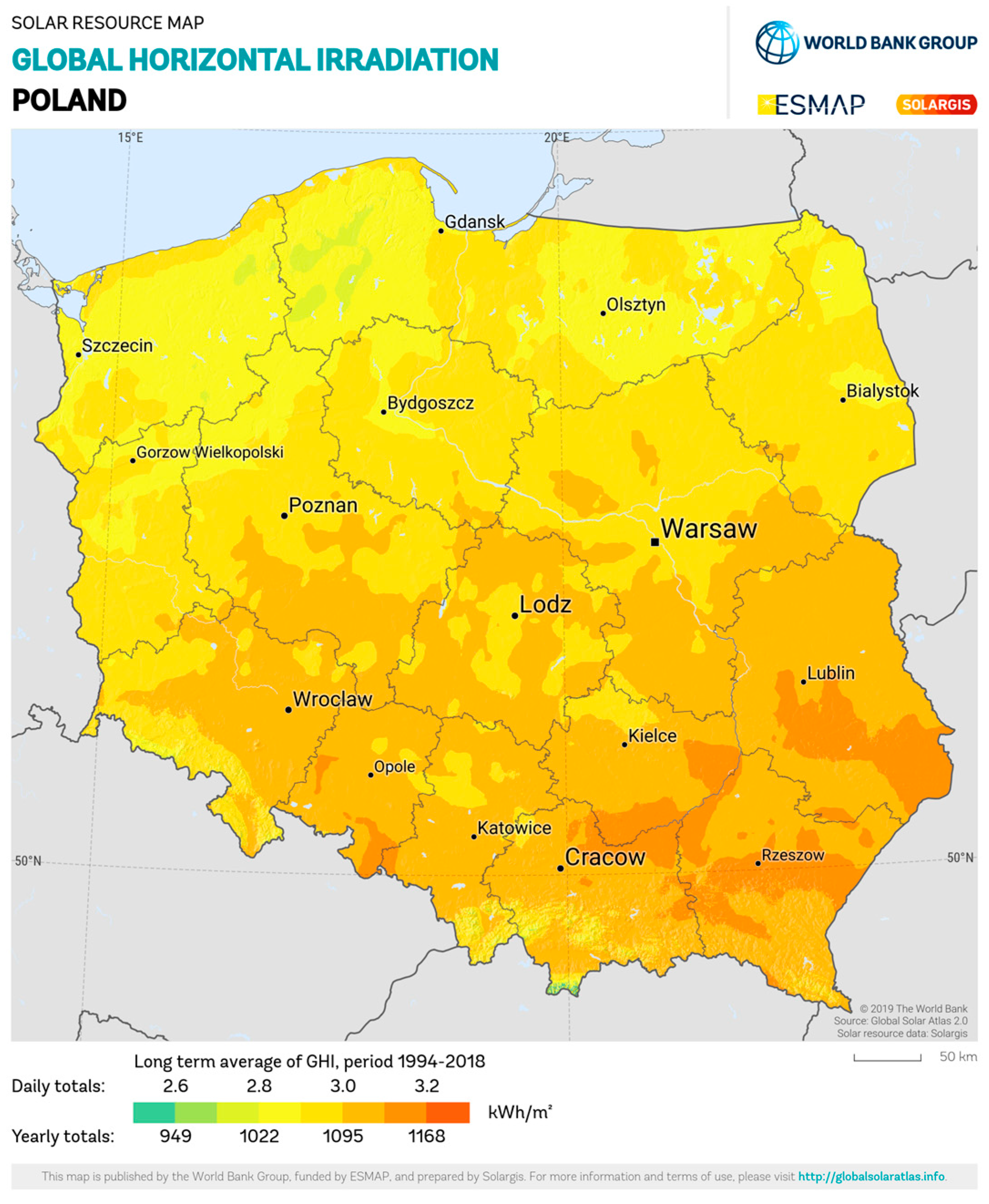

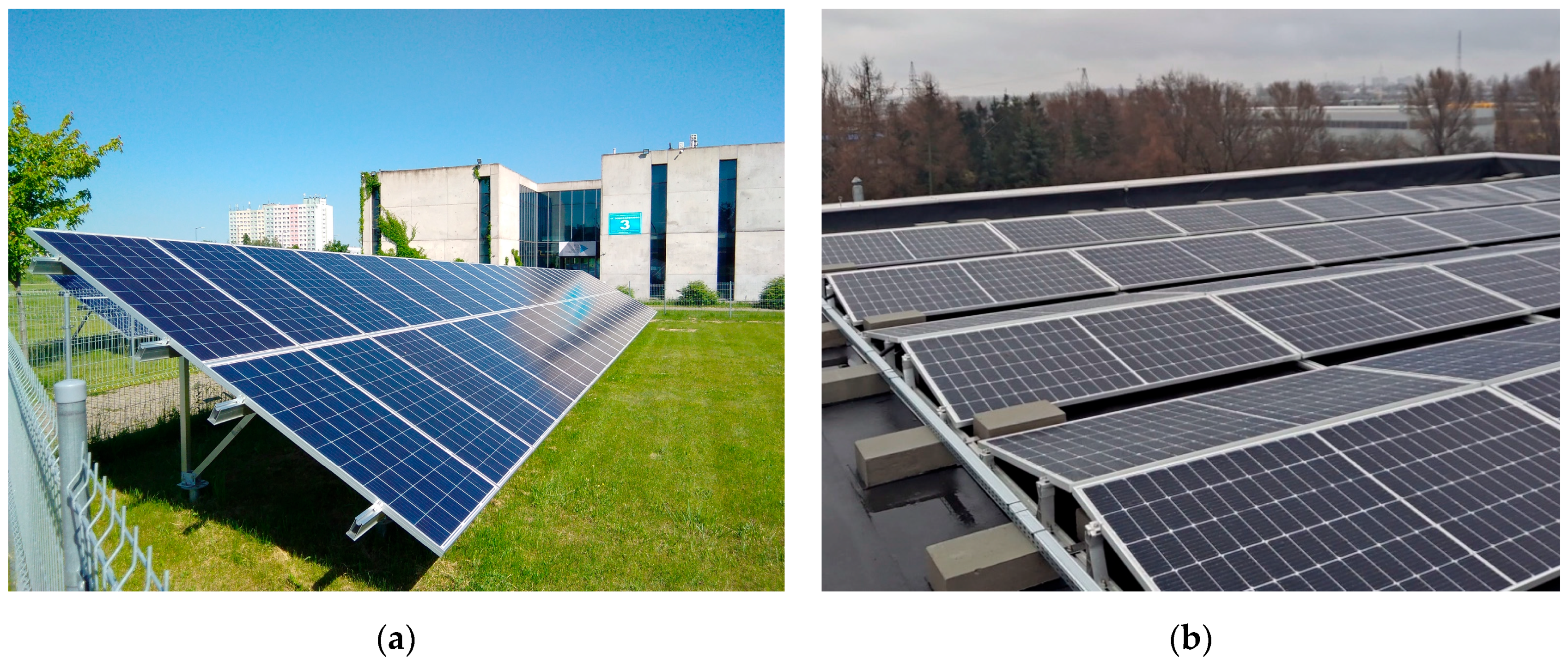
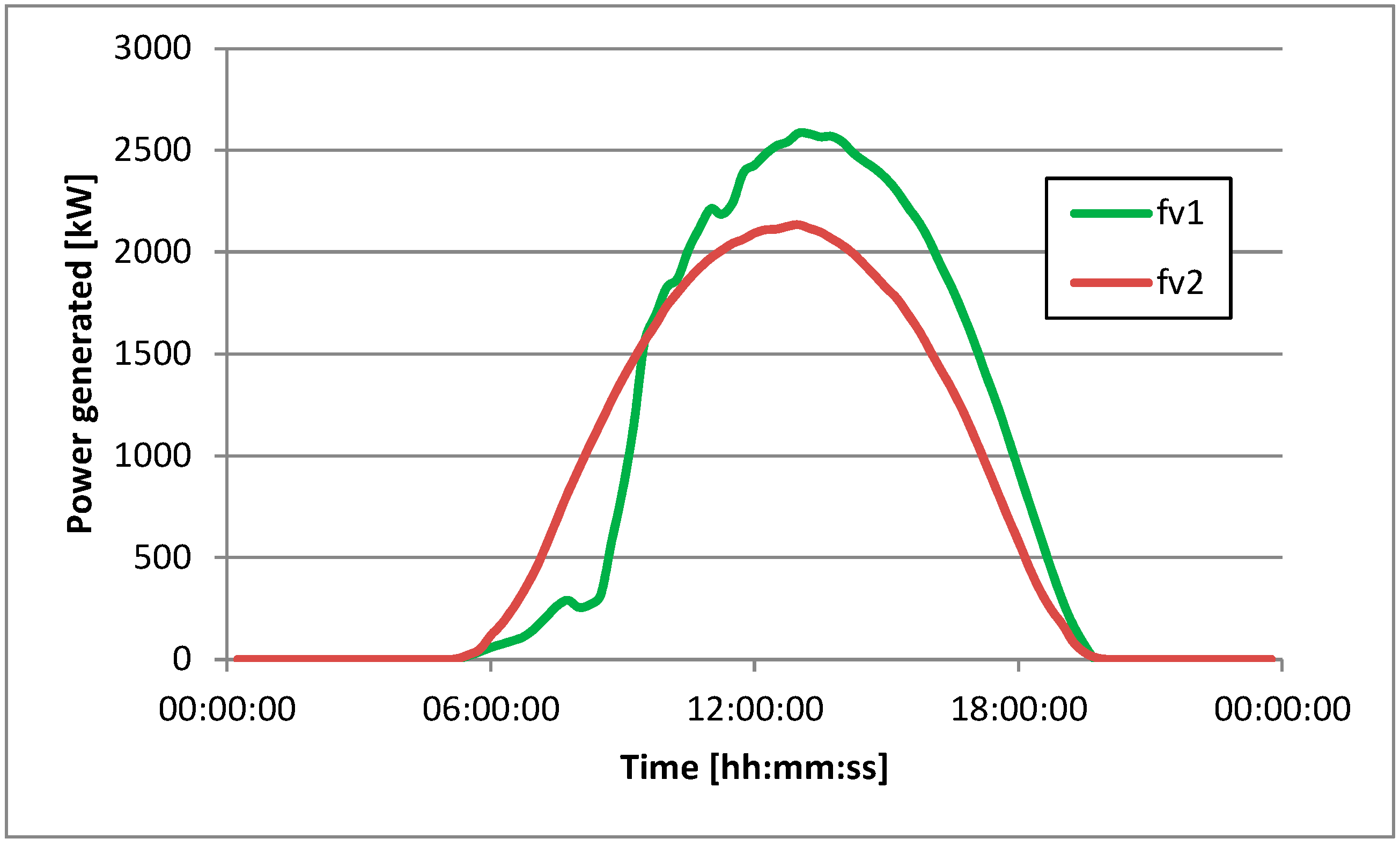
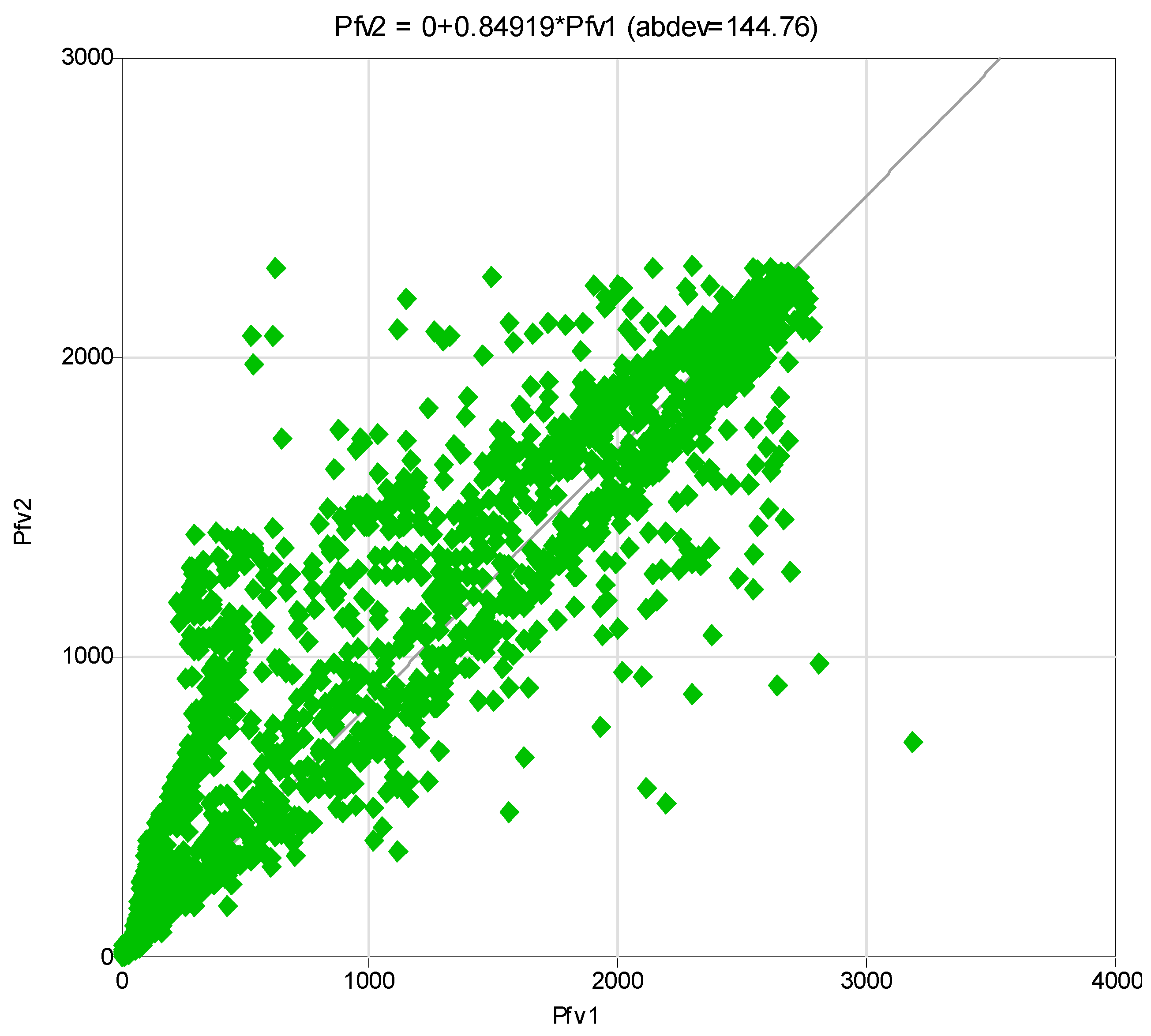
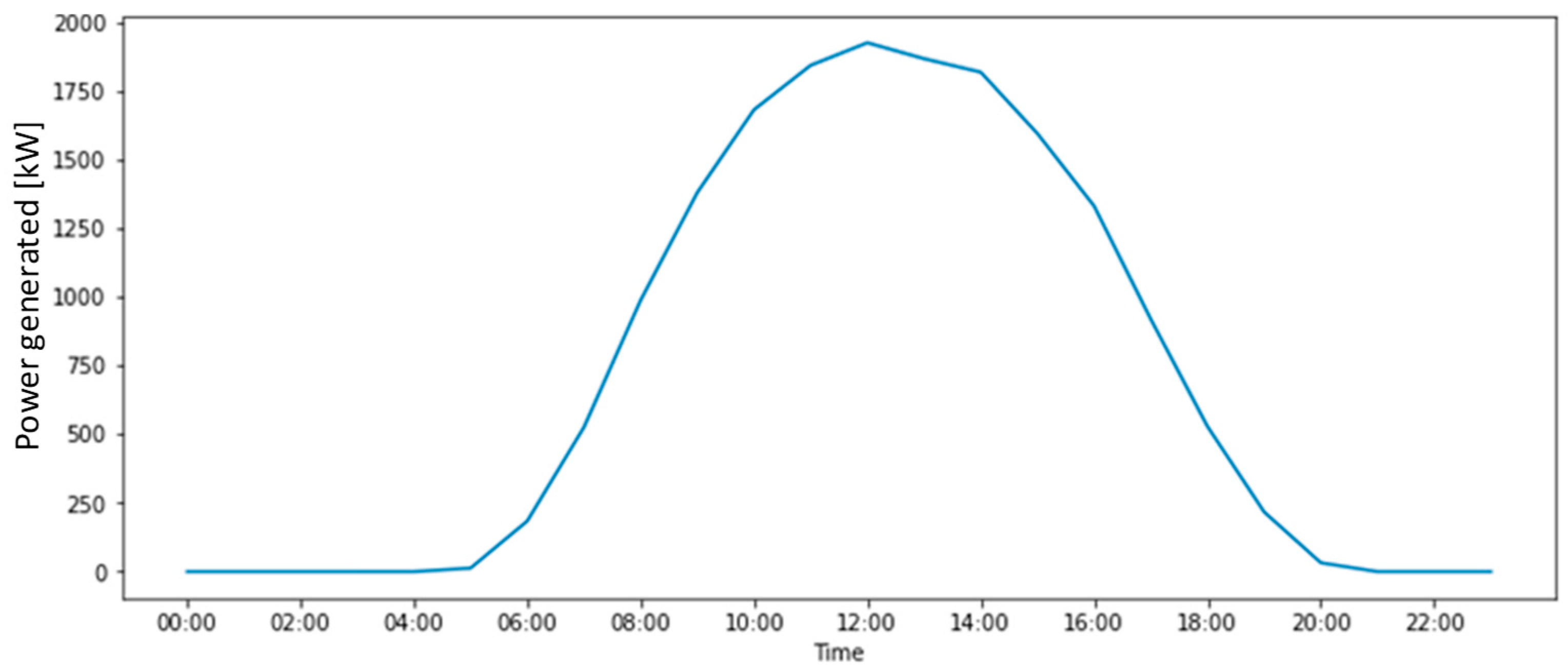
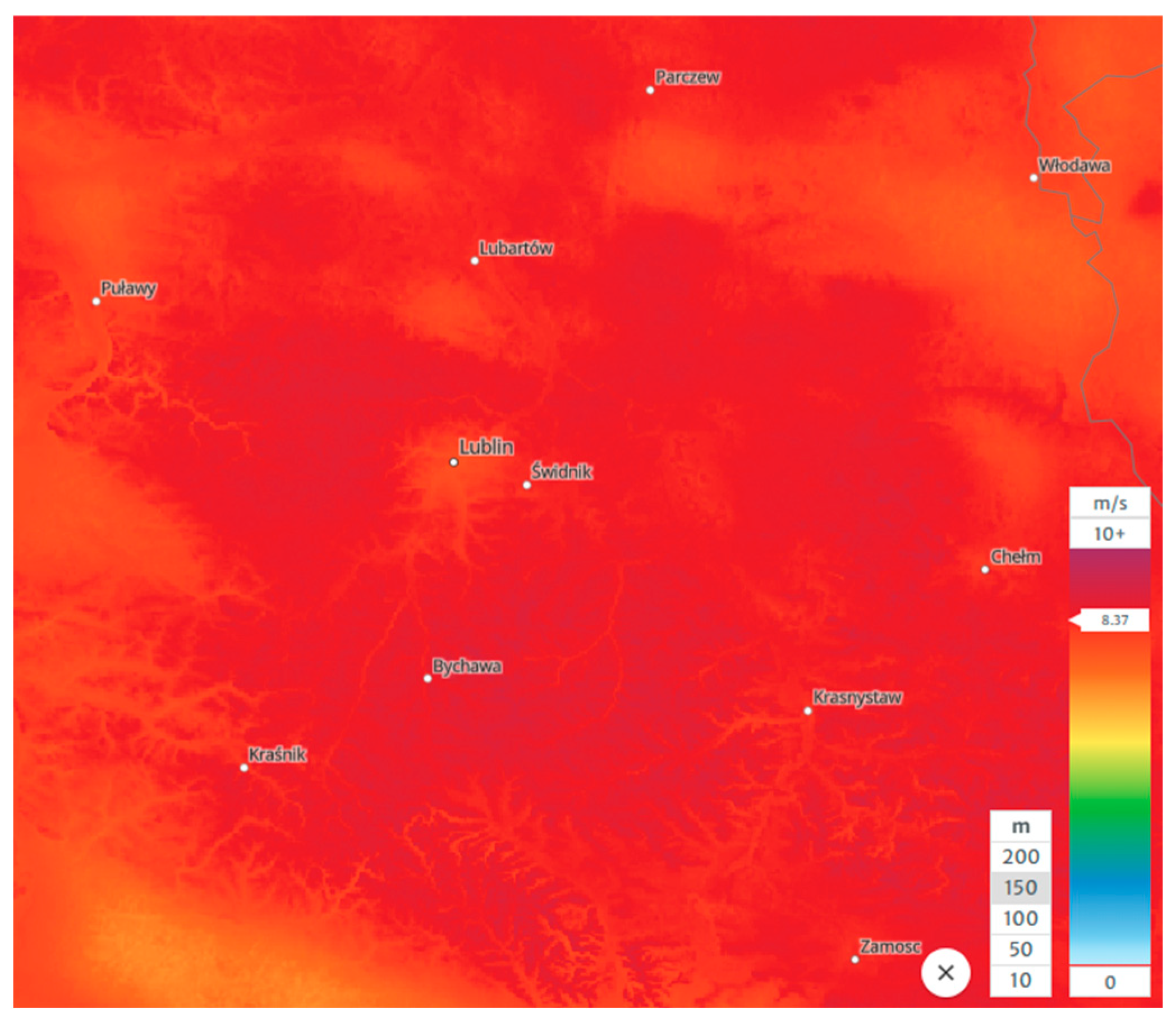

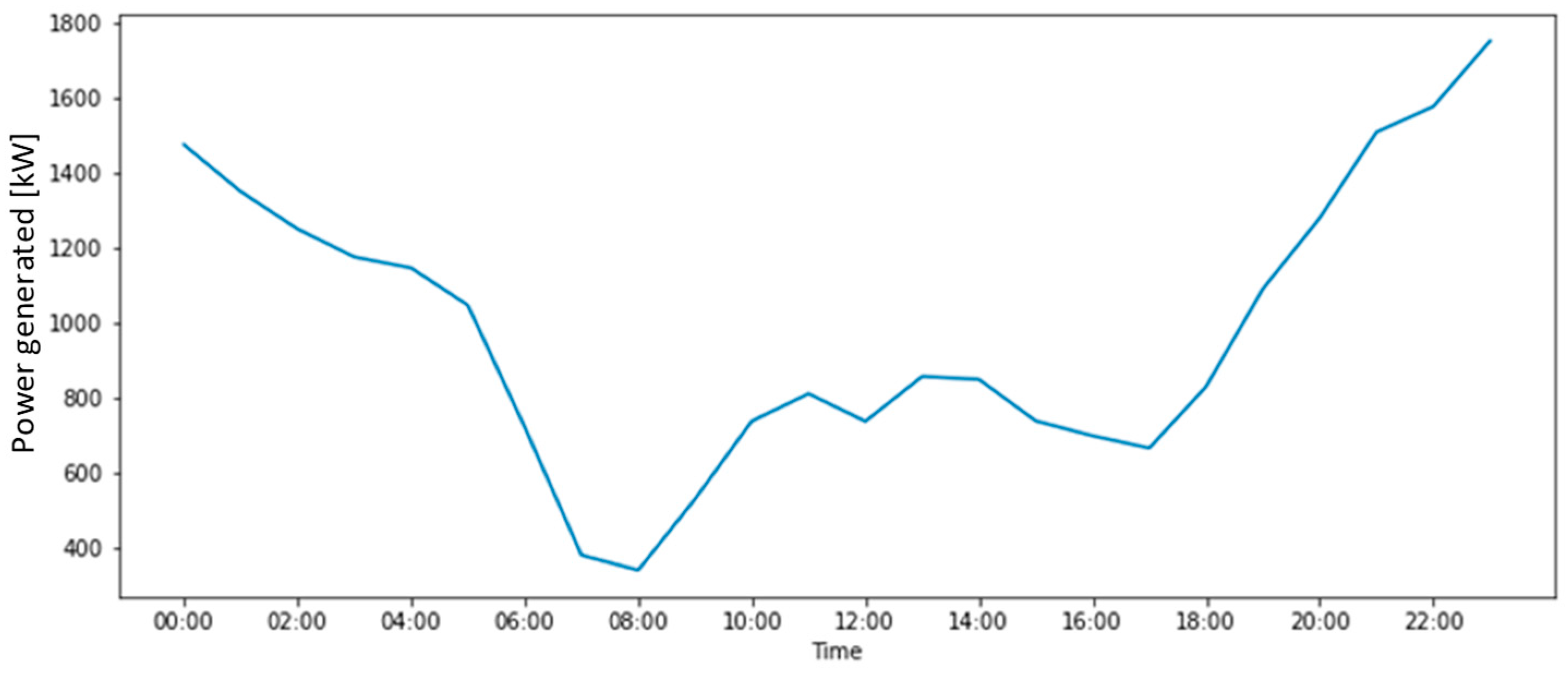
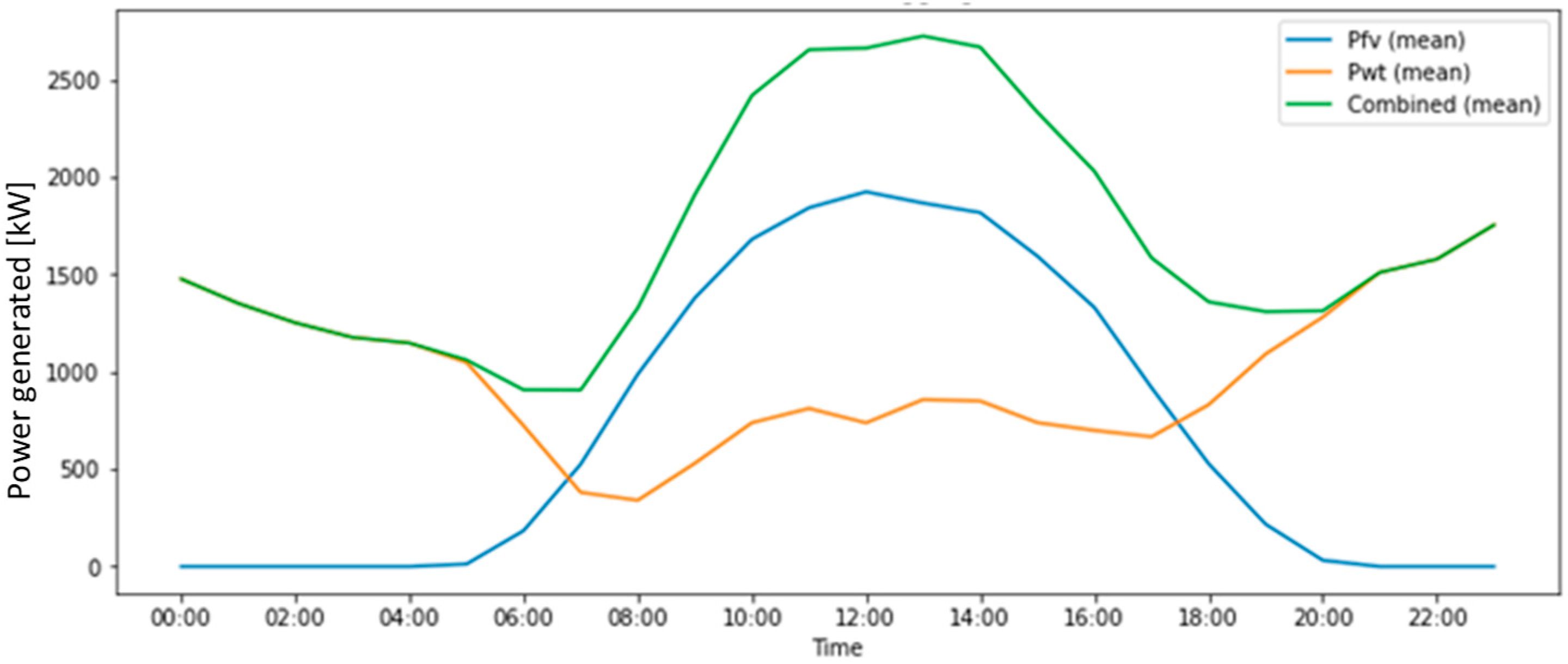
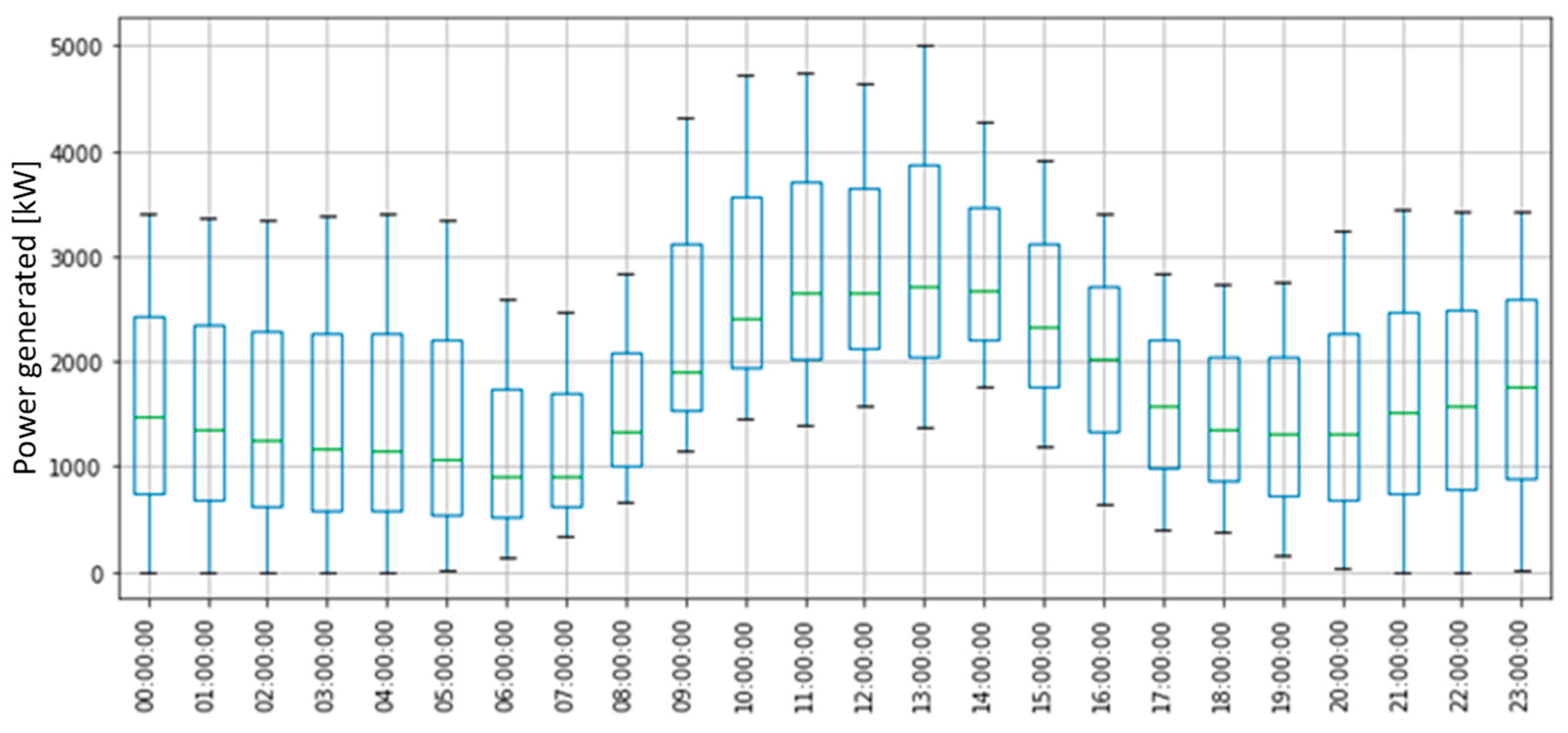
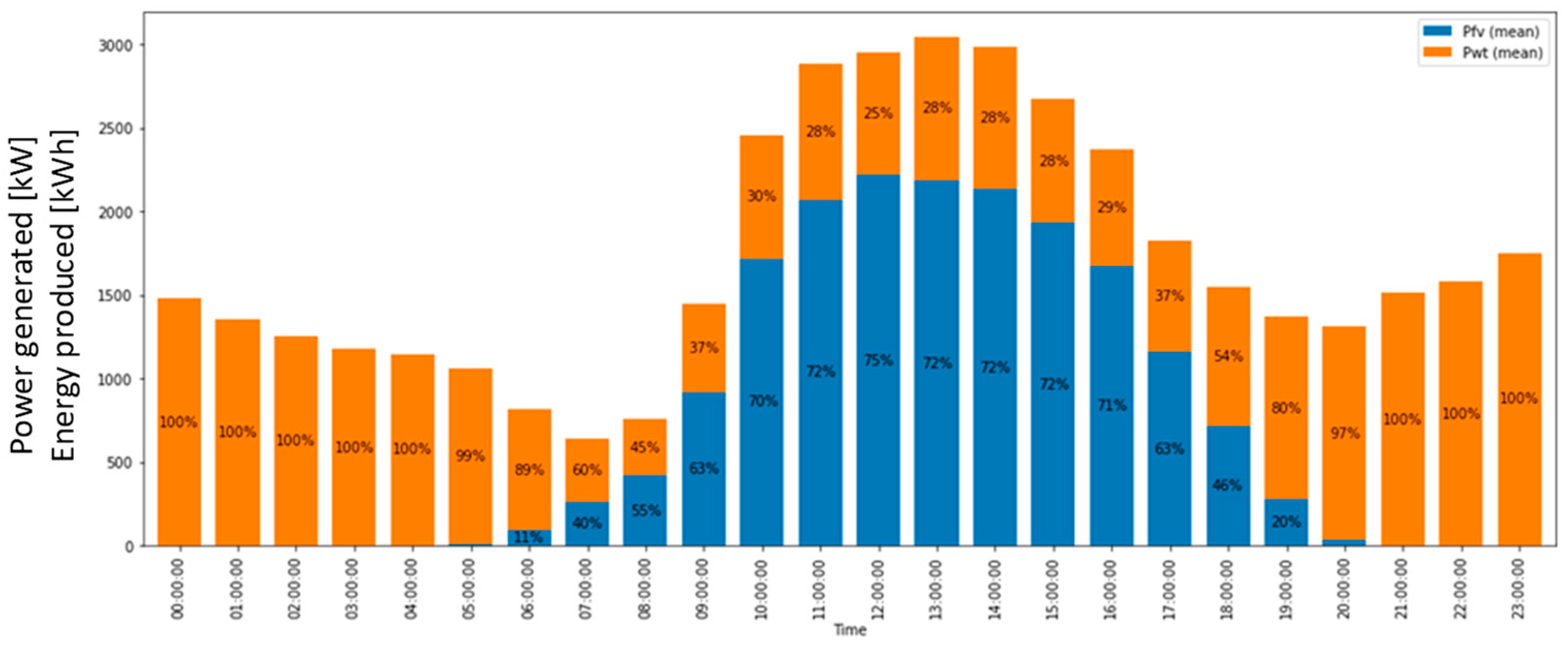
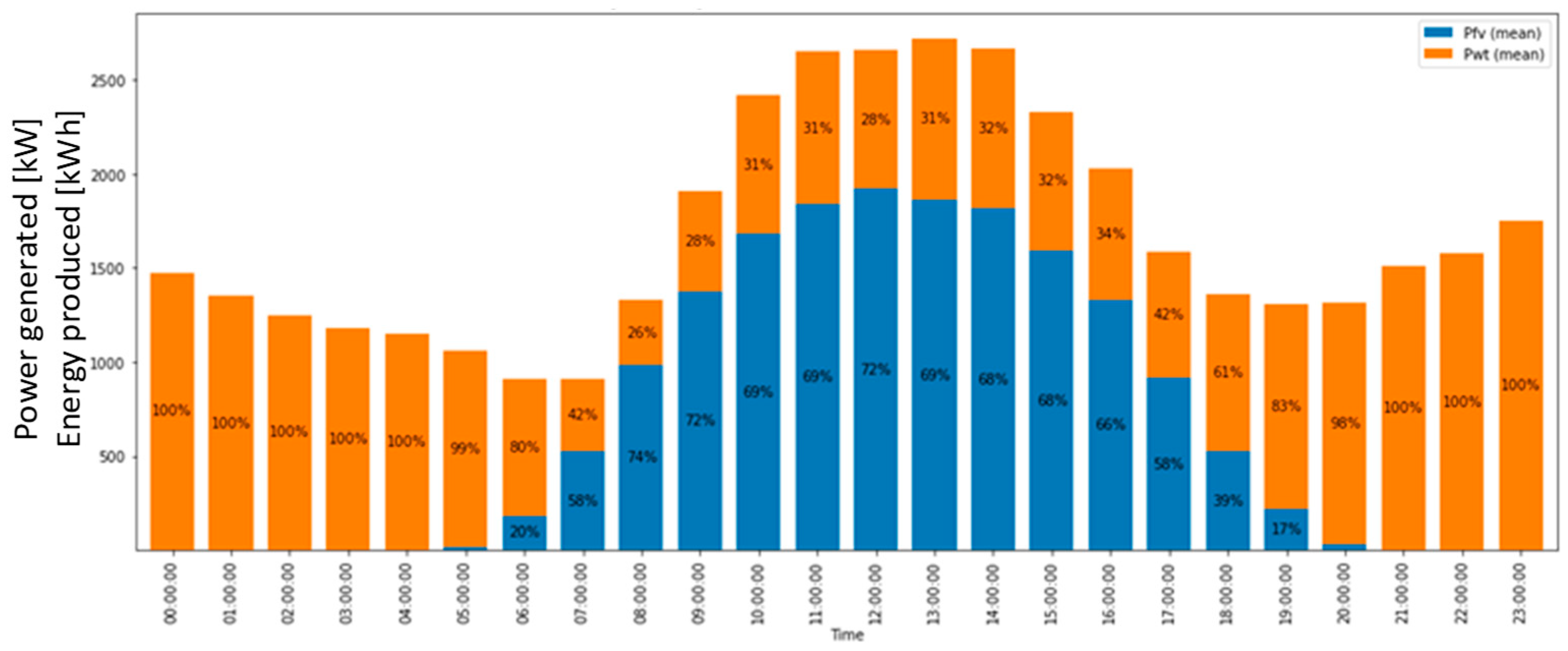
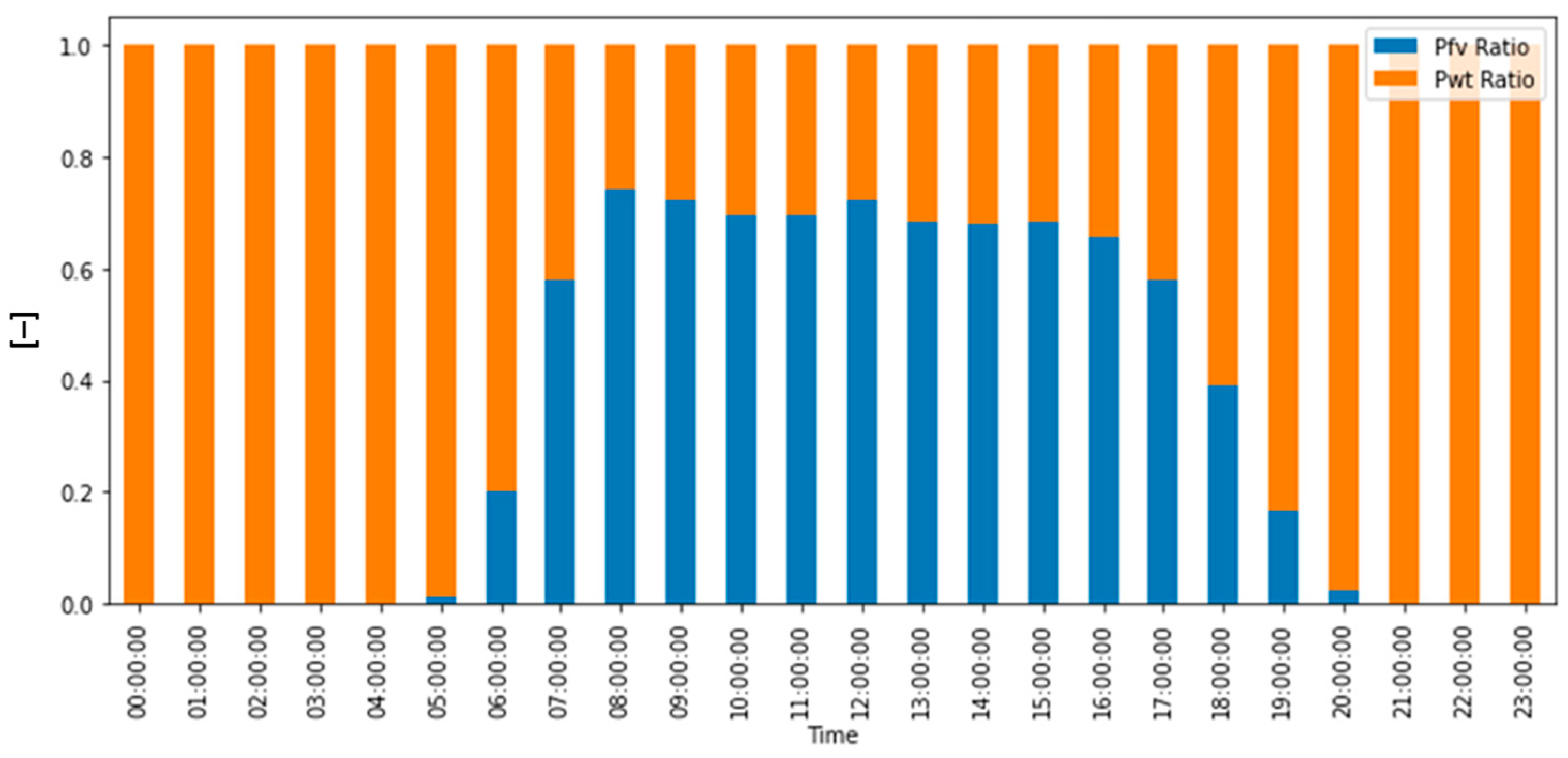

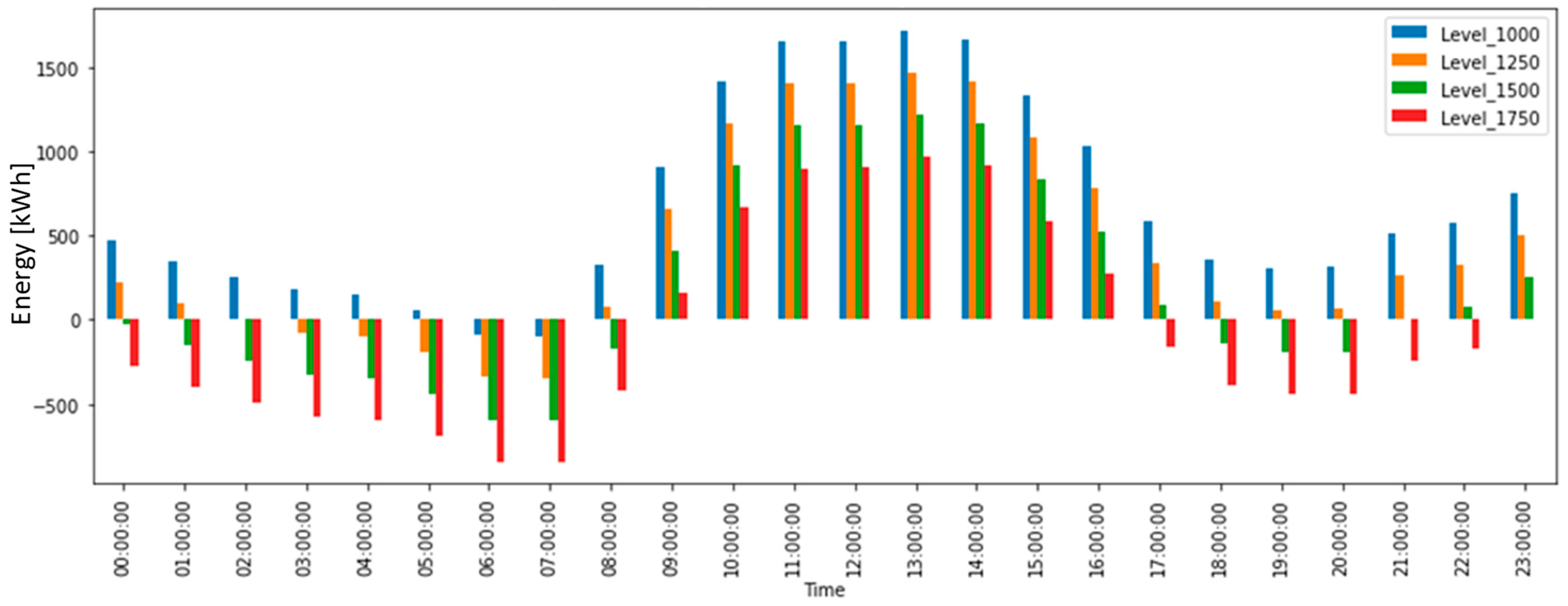

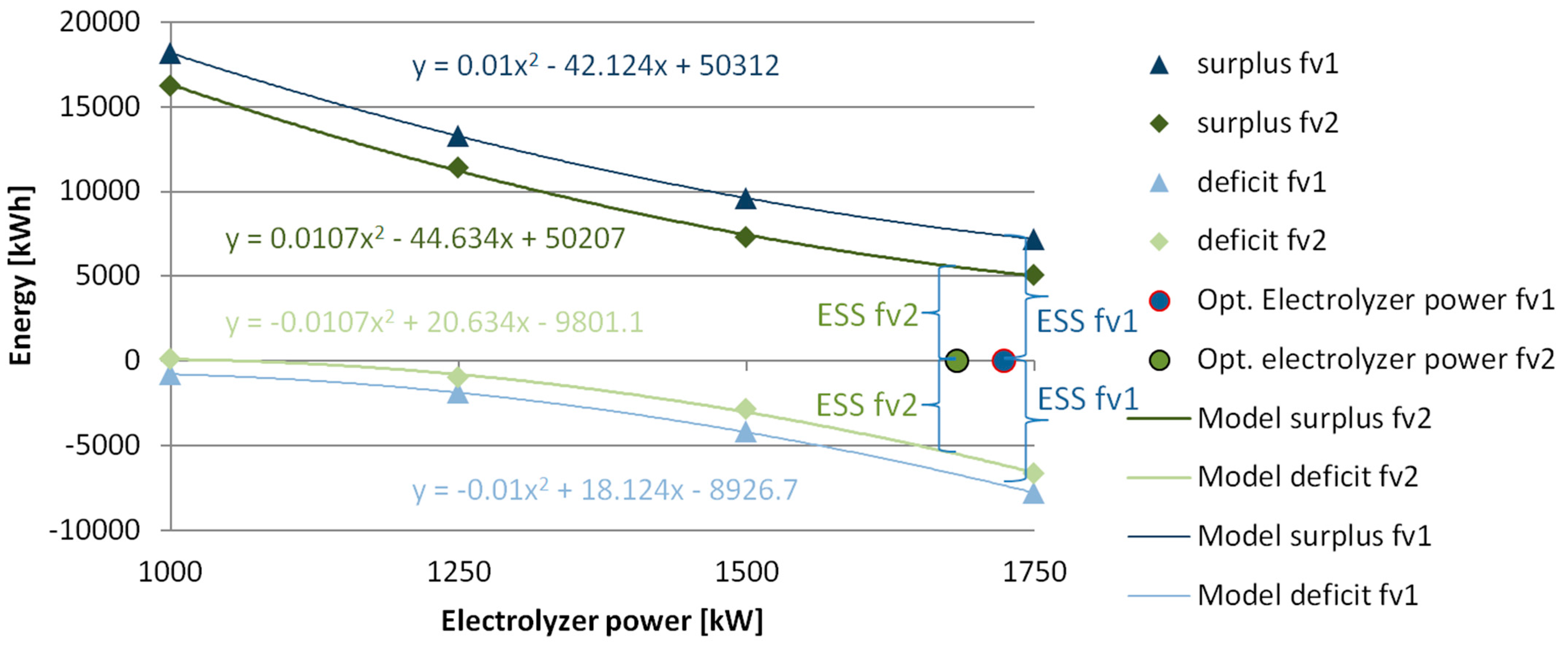
| Country | Mean | Std | Min | 10% | 20% | 30% | 40% | 50% | 60% | 70% | 80% | 90% | 95% | 99% | Max | |
|---|---|---|---|---|---|---|---|---|---|---|---|---|---|---|---|---|
| Pfv | 24.00 | 701.58 | 767.69 | 0.00 | 0.00 | 0.00 | 0.02 | 62.59 | 371.26 | 840.46 | 1335.10 | 1628.42 | 1834.47 | 1862.38 | 1910.59 | 1923.91 |
| Pwt | 24.00 | 981.98 | 381.12 | 340.18 | 571.07 | 713.29 | 738.33 | 815.31 | 853.63 | 1082.67 | 1184.00 | 1308.77 | 1499.95 | 1567.79 | 1713.21 | 1753.61 |
| Combined | 24.00 | 1683.56 | 594.34 | 906.09 | 1086.54 | 1221.41 | 1312.26 | 1352.76 | 1493.21 | 1583.53 | 1921.28 | 2367.06 | 2659.17 | 2666.06 | 2710.45 | 2723.47 |
| Time | 00:00 | 01:00 | 02:00 | 03:00 | 04:00 | 05:00 | 06:00 | 07:00 | 08:00 | 09:00 | 10:00 | 11:00 | 12:00 | 13:00 | 14:00 | 15:00 | 16:00 | 17:00 | 18:00 | 19:00 | 20:00 | 21:00 | 22:00 | 23:00 |
|---|---|---|---|---|---|---|---|---|---|---|---|---|---|---|---|---|---|---|---|---|---|---|---|---|
| Level_750 | 0.69 | 0.61 | 0.58 | 0.58 | 0.61 | 0.55 | 0.48 | 0.52 | 0.97 | 1.00 | 1.00 | 1.00 | 1.00 | 1.00 | 1.00 | 1.00 | 0.97 | 0.97 | 0.84 | 0.77 | 0.68 | 0.71 | 0.77 | 0.77 |
| Level_1000 | 0.69 | 0.52 | 0.52 | 0.48 | 0.52 | 0.35 | 0.32 | 0.32 | 0.87 | 1.00 | 1.00 | 1.00 | 1.00 | 1.00 | 1.00 | 1.00 | 0.90 | 0.84 | 0.68 | 0.61 | 0.58 | 0.58 | 0.74 | 0.77 |
| Level_1250 | 0.56 | 0.48 | 0.42 | 0.35 | 0.29 | 0.26 | 0.26 | 0.16 | 0.39 | 0.97 | 1.00 | 1.00 | 1.00 | 1.00 | 1.00 | 0.97 | 0.90 | 0.65 | 0.48 | 0.42 | 0.48 | 0.55 | 0.52 | 0.68 |
| Level_1500 | 0.53 | 0.42 | 0.42 | 0.29 | 0.29 | 0.23 | 0.19 | 0.06 | 0.23 | 0.84 | 0.97 | 0.97 | 1.00 | 0.94 | 1.00 | 0.90 | 0.81 | 0.48 | 0.39 | 0.39 | 0.45 | 0.52 | 0.52 | 0.61 |
| Level_1775 | 0.38 | 0.35 | 0.32 | 0.26 | 0.19 | 0.19 | 0.16 | 0.06 | 0.13 | 0.35 | 0.90 | 0.90 | 0.97 | 0.90 | 1.00 | 0.81 | 0.58 | 0.39 | 0.26 | 0.26 | 0.29 | 0.48 | 0.45 | 0.48 |
| Level | Energy Surplus [kWh] | Energy Deficit [kWh] | Balance [kWh] | Energy Surplus (Model) [kWh] | Energy Surplus (Model) [kWh] |
|---|---|---|---|---|---|
| Level_1000 | 16,265.17 | 140.37 | 16,273 | 132.9 | 16,265.17 |
| Level_1250 | 11,380.81 | −975.27 | 11,133.25 | −727.35 | 11,380.81 |
| Level_1500 | 7271.36 | −2865.82 | 7331 | −2925.1 | 7271.36 |
| Level_1750 | 5074.42 | −6668.88 | 4866.25 | −6460.35 | 5074.42 |
| Level_1683.58 | 5391 | −5391 |
Disclaimer/Publisher’s Note: The statements, opinions and data contained in all publications are solely those of the individual author(s) and contributor(s) and not of MDPI and/or the editor(s). MDPI and/or the editor(s) disclaim responsibility for any injury to people or property resulting from any ideas, methods, instructions or products referred to in the content. |
© 2025 by the authors. Licensee MDPI, Basel, Switzerland. This article is an open access article distributed under the terms and conditions of the Creative Commons Attribution (CC BY) license (https://creativecommons.org/licenses/by/4.0/).
Share and Cite
Małek, A.; Dudziak, A.; Marciniak, A.; Słowik, T. Designing a Photovoltaic–Wind Energy Mix with Energy Storage for Low-Emission Hydrogen Production. Energies 2025, 18, 846. https://doi.org/10.3390/en18040846
Małek A, Dudziak A, Marciniak A, Słowik T. Designing a Photovoltaic–Wind Energy Mix with Energy Storage for Low-Emission Hydrogen Production. Energies. 2025; 18(4):846. https://doi.org/10.3390/en18040846
Chicago/Turabian StyleMałek, Arkadiusz, Agnieszka Dudziak, Andrzej Marciniak, and Tomasz Słowik. 2025. "Designing a Photovoltaic–Wind Energy Mix with Energy Storage for Low-Emission Hydrogen Production" Energies 18, no. 4: 846. https://doi.org/10.3390/en18040846
APA StyleMałek, A., Dudziak, A., Marciniak, A., & Słowik, T. (2025). Designing a Photovoltaic–Wind Energy Mix with Energy Storage for Low-Emission Hydrogen Production. Energies, 18(4), 846. https://doi.org/10.3390/en18040846








